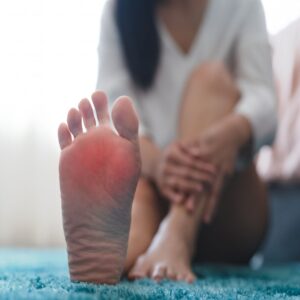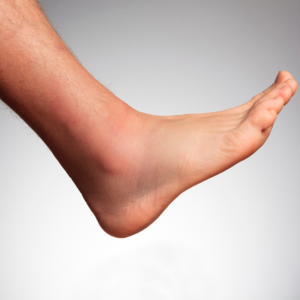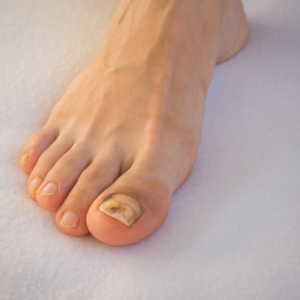How Often Should You Visit a Podiatrist?
Footcare is essential but often overlooked by many. When was the last time you visited a podiatrist? The answer for most, unfortunately, is well over what it should be. You might be shocked to learn that you should be visiting a podiatrist at least once a year! We need our feet for many things, it’s good to make sure they’re healthy. If you need a Podiatrist on Long Island that Accepts Medicaid, let CEC Health Center be your choice.
Why Do You Need To Visit A Podiatrist Once A Year?
You might have been surprised to learn that you should visit a podiatrist this often, but why is this the case? Everyday life takes a toll on the feet way more than one would expect. Simple things like standing around all day for work, walking, running, and jumping can put pressure on the feet that can have long-lasting effects. These effects can lead to injury, infections, and even disease. Age is also a big factor in this degrading health of our feet. As we get older, we lose fat in our feet, which puts more pressure on the bones. Our ligaments and tendons lose strength and flexibility. We can develop arthritis of the joints, which makes it harder to stay active. Sometimes, even wearing your favorite pair of shoes can become a horrifically uncomfortable ordeal. However, many people don’t even know what a podiatrist is or does! Visit our Podiatrist on Long Island that Accepts Medicaid today!
What Does A Podiatrist Do That Is So Essential?
Most know that a podiatrist is a doctor who specializes in the foot and ankle area. Visiting your local podiatrist can help diagnose a wealth of problems you might not have even known about. They can set fractures if needed, write prescriptions for foot pain, direct you to physical therapy, and sometimes perform surgery. They can also diagnose and treat a wealth of issues, including:
- Foot and ankle injuries.
- Plantar fasciitis, inflammation of a band of tissue that connects the heel and toes.
- Arthritis, swelling, and tenderness of joints, worsen with age and causes pain and stiffness.
- Sprains and strains in the area.
- Bunions, warts, corns, calluses, blisters, and more. These all cause pain for various reasons and can be uncomfortable.
- Various toe deformities, like hammertoe, when your toe has an additional bend in the middle joint. Claw toe, when your toes point downwards and dig into things. A mallet toe, when the extra bend in your toe points upwards.
- Flat foot, where you have no arch in your foot. Can cause extreme amounts of pain and usually requires shoe inserts.
- Ingrown toenails, when your toenail grows into your flesh and is usually irritating and painful. Podiatrists can cut these for you.
- Nail and foot infections.
CEC Health Center
- Heel spurs and pain. Heel spurs are calcium buildups in your heel that create a bone-like protrusion, which causes pain when your heel strikes the ground. This makes it very difficult to walk.
- General foot and ankle pain, podiatrists can diagnose and treat.
- Skin problems, such as dry and cracked skin.
- Nail problems, from diseases to pain.
- Muscle pain, or similar afflictions.
- Diabetes-related problems. Diabetes can lead to poor circulation and nerve damage in the feet. These can cause infections, ulcers, sores, and toe deformities. Minor issues can escalate and possibly lead to amputation if left untreated. If you have diabetes, you should visit a podiatrist every 3 to 6 months instead of once a year, as this should be taken extremely seriously.
If you’d like to learn more about what a Podiatrist on Long Island that Accepts Medicaid can do for you, contact us today!
CEC Health Center – Podiatrist on Long Island that Accepts Medicaid
If any of this applies to you, or you simply want to make sure everything is ok after some time, you can visit us at CEC Health Center in Bethpage or call us at (516) 622-8888. We are committed to providing excellent healthcare services to historically underserved community members with limited incomes. Our team of professionals is more than happy to offer all the podiatry services you could need. Not many podiatrists accept Medicaid as well, so for a Podiatrist on Long Island that Accepts Medicaid, you can’t go wrong with us. Visit the CEC Health Center today!
Preventing Foot and Ankle Injuries
Your foot is so much more complicated than you realize. It is made up of 26 bones and 33 joints! Your ankle joint alone has three bones in it, and these bones are held together throughout your foot and ankle by numerous ligaments, tendons, nerves, and muscles. All of these body parts help to support your whole body while walking, running, jumping, pretty much anything you do involving your feet. Unfortunately, the flexibility and strength of these joints and bones give our bodies a higher risk of injury. If you’re looking for a Podiatrist on Long Island that Accepts Medicaid then the CEC Health Center is the place for you!

The CEC Health Center provides integrated healthcare services at 3 of its locations. We provide care with compassion to impoverished community members with limited incomes. Also, we cater to those individuals with autism, learning disabilities, and behavioral health concerns. They focus on preventative healthcare to ensure healthy lifestyles and to minimize trips to the emergency room. The CEC Health Center services are available to all community members and accept Medicare, Medicaid, Medicaid Managed Care, and private insurance plans. Their physicians and support staff are bi-lingual in English and Spanish, and other interpreters are provided if needed by individuals.
Common Causes of Foot and Ankle Injury
The most common cause of foot and ankle injuries are car accidents and sports-related activities in fractures and sprains. Ordinary slips and falls lead to less severe injuries in those areas of the body. Other causes could be age-related wear and tear on the body. Calcium breakdown over the years will cause your bones to be more fragile as well. Any sports that rely on constant torque of the feet or ankles such as, football, hockey, baseball/softball, volleyball, running, skiing, snowboarding, etc., are ones to keep an eye on your foot and ankle health. Lastly, the type of shoes you wear is highly crucial if/any injuries would occur, such as bunions, corns, and calluses. Injuries can also be caused over time by overuse or repetitive motions done over a long period. Visit our Podiatrist on Long Island that Accepts Medicaid for all of your foot injuries today!
Common Injuries
The most common foot and ankle injuries are as follows:
- Arthritis – painful inflammation and stiffness are usually brought on by many degenerative joint conditions. Symptoms typically include swelling, tenderness, sharp pain, and sometimes even a fever.
- Bursitis – is caused by the inflammation of fluid-filled sacs that are supposed to reduce inflammation in the joints. An infection or an injury often brings on bursitis. Common symptoms are pain, swelling, or reduced range of motion.
- Fracture – fractures occur when the bone breaks through the skin after the bone break occurs. Stress fractures and hairline fractures occur when repeated stress continues on the bone.
- Sprains and Strains – Sprains are stretched or torn ligaments. A strain is similar to a sprain but occurs in the muscle as opposed to the ligaments.
- Tendonitis – this is the inflammation of tendons and is mainly caused by overuse. Symptoms of this are pain and decreased range of motion.
How To Prevent Foot and Ankle Injury With Our Podiatrist on Long Island that Accepts Medicaid
It’s straightforward to make sure that your foot and ankle health stay at the forefront of your everyday health and make sure that you prevent any kinds of injuries. Stretching before any physical activity for at least 15 minutes. Cross-training in different activities will help condition your muscles for any event. It is making sure that you are choosing the correct shoes for your foot shape. People whose feet pronated or who have low arches should choose shoes that support both the front and under the arch.
Those with stiffer feet or high arches should choose shoes with more cushion and a softer platform. Replace your shoes when the tread starts to run out. They should be replaced every six months. Try your best to avoid uneven surfaces, and if you have issues in your lower body, walking on a dirt road would be the best for you. Lastly, listen to your body when it is telling you something. If you have pain of any kind, you need to get it checked or rest from your performing activities.
CEC Health Center– Podiatrist on Long Island that Accepts Medicaid
Finding a doctor that will cater to your needs in the most personal and professional way possible is what the CEC Health Center will do for you as a patient. Ensuring that your health needs are coming first and that your recovery is speedy and full of information that you need to go on with your life to make it healthy and happy for the long term. If you’re looking for a Podiatrist on Long Island that Accepts Medicaid then the CEC Health Center is the place for you!
Common Foot Problems in Older Adults?
Our feet are so crucial to our body, and it carries the weight of our bodies and experience a lot of tearing. As we get older, foot problems become more familiar to us and can occur more frequently than we think, and you start to experience foot pain, stiffness, or aching in your feet. At CEC Health Center, we want to make sure that we can provide you with the best care and excellent recovery from any pain that you can be experiencing. We need to ensure that we are offering you the best services possible as the Podiatrist on Long Island that Accepts Medicaid.
Common Foot Problems: 
There are so many different foot problems that can occur, but we are going to take a look at the most common ones, including:
- Bunions: bony bumps that form on the joint at the base of your big toe
- Corns: smaller calluses that have a hard center surrounded by inflamed skin
- Calluses: hard and thick patches of skin
- Ingrown: the corner or the side of your toenail grows into the sift flesh
- Thickened or discolorated nails: this can be a sign to indicate that there is a fungal infection and can become painful.
- Diabetic foot conditions: change in skin color, swelling of the foot or ankle, and can include bunions, corns, calluses, and hammertoes
- Poor circulation: this can happen with many different conditions, some including smoking and obesity
- Heel pain: can be a sign of plantar fasciitis, which can happen when a spur is present in the heel.
Triggers of Foot Problems:
We want to make sure that you know that you are experiencing foot problems and avoiding the issue. Here are some situations where you can start to notice that foot pain on your own:
- The pain can come on suddenly and is severe (pinching, not being able to stand on your feet)
- Not being able to place any weight on your foot
- The area that is causing you pain is red or has any of the following symptoms listed above
- Having a fever in addition to having foot pain
Podiatrist on Long Island that Accepts Medicaid Foot Problems?
There are many different things that you can do on a daily that you might overlook that can cause you pain and foot problems in the future or even now. Here are so many ways that you can help yourself prevent that from happening. There is the fact that you can have an injury in your foot, whether it is a fracture or an injury that had taken its time to develop. You can overuse your foot which can cause inflammation that involves the bones, ligaments, or tendons in the foot that can cause foot pain. You can also find yourself having an injury in the nerve of your feet, which can result in intense burning, numbness, or tingling. Contact our Podiatrist on Long Island that Accepts Medicaid if you’re dealing with any of these complications.
Avoid Foot Problems Now and In The Future:

There are so many different things that you can do to make sure you can avoid those foot problems now and anywhere in the future. Below I am going to list something’s that you can do to help prevent foot problems:
- Choose comfortable, roomy, and well-cushioned shoes.
- Avoid shoes with high heels and that have narrow toe areas.
- Maintaining a healthy weight, in which you will not be putting a lot of pressure on your feet, and you will have enough support for yourself.
- It’s best to begin stretching before engaging in vigorous exercise.
- Practicing good foot hygiene
- Making sure you are always wearing footwear when you are outside to protect the bottom of your feet.
Contact Our Podiatrist on Long Island that Accepts Medicaid
Yes, foot pain is common, but it should not be a normal part of life. We want to help you prevent the pain from becoming an everyday occurrence for you. We can offer those kinds of services to avoid injuries that can worsen for you in the long run. At CEC Health Center, we’re a Podiatrist on Long Island that Accepts Medicaid. We want to provide you with the best experience and the best possible care for yourself. Contact us for more information and to schedule an appointment with the CEC Health Center.
How Can I Treat My Achilles Tendonitis?

Achilles tendonitis is the overuse of the Achilles, which is the tissue connecting your calf muscle to your heel. If you’re experiencing this condition, a Podiatrist on Long Island that Accepts Medicaid will be there to help. Our very own CEC Health Center will confirm the diagnosis of Achilles tendonitis and determine the best form of treatment moving forward. We’d also like to share more information about this condition so you’ll be able to recognize right away when your Achilles has become affected by this issue.
What Is Achilles Tendonitis?
Achilles tendonitis is when the tendon in the back of your leg becomes inflamed and irritated from overworking it. It is the largest tendon in the body and is used for everyday activities such as walking, running, going up the stairs, going on your tiptoes.
Recognizing the Signs
Engaging in daily activities that involve walking and running and jumping, experiencing sporadic pain in the lower leg area can be expected. Being cognizant of how your body is feeling daily can help determine when a severe issue occurs. While pain in the back of your leg is the leading symptom of Achilles tendonitis, there are many others. The below symptoms also will infer that you may be suffering from this condition:
- Thickening of the tendon
- Swelling
- Bone spur
Be sure to visit a Podiatrist on Long Island that Accepts Medicaid if you are experiencing these symptoms.
Common Causes Of Achilles Tendonitis
Achilles tendonitis can be the result of partaking in various activities. At CEC Health Center, we have also seen patients develop this condition as a result of participating in the below activities:
- Running
- Jumping
- Putting weight on your feet
When To VisitCEC Health Center
After experiencing pain in your lower leg due to this condition, it’s easy to believe you can handle this on your own. However, there are times when resting and ice is not enough to correct the issue. When you begin to experience the below, we recommend that you contact us for treatment:
- Inability to walk
- Leg appears swollen
- High levels of discomfort
Treating Achilles Tendonitis
After being diagnosed with Achilles tendonitis, the first type of treatment CEC Health Center will recommend is physical therapy. This form of treatment is non-invasive and uses a mixture of physical-based activities to promote treatment. Below are some of the things that you can do to treat yourself before coming in.
- Medication
- Rest
- Ice
- Compression
- Elevation
- Brace or splint
These sources can be provided to you at a Podiatrist on Long Island that Accepts Medicaid called CEC Health Center. Visit our website and make an appointment today!
In some cases, you may need to have surgery. They will take out the tissue and repair the tendon back to normal. The healing process could take a while, and you will need to rest afterward.
Preventing Achilles Tendonitis
- Make sure to gradually increase your activity level gradually- Try to slowly increase the amount and intensity to prevent injury.
- Choose the right shoes- The correct shoes will change everything and make you more comfortable. You want your feet to be supported in the right areas to decrease the chance of injury.
- Strengthen your calf muscles- Having strong calf muscles will let you put more strain on your Achilles without hurting it.
- Cross-train- Make sure to switch up how you exercise. Don’t do the same thing every time and use the same muscles. Maybe bike sometimes or lift weights instead of running miles upon miles every day.
- Stretch- Increasing your calf flexibility before and after exercise will prevent these injuries from recurring.
Contact Our Podiatrist on Long Island that Accepts Medicaid!
The sooner you can recognize you are suffering from Achilles tendonitis, the faster you’ll be able to seek out treatment. Be sure to request an appointment with our team at CEC Health Center, a Podiatrist on Long Island that Accepts Medicaid, so you can take the first steps in regaining the functionality of your leg today! Not only will we treat you, but we will also educate you so that you can prevent future injuries!
